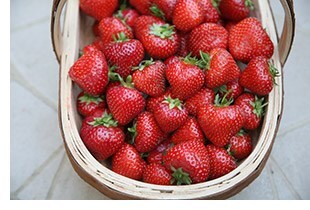Strawberries

My strawberry patch has run amok, thrown off the veneer of respectability and is having a riotous party hovering somewhere between anarchy and abject chaos.
The trouble is, I’ve let the law and order slip: I haven’t got round to snipping off my runners and they’ve been breeding like rabbits. This should be a weekly job during summer, and I’ll probably pay for my laziness next year, as the parents have become so keen on making babies they’ll be far too exhausted to produce me any nice strawbs. On the plus side, they’re growing so thickly the weeds haven’t had a look-in.
 Letting your strawberry patch grow into a mat might seem tempting: after all, you get a ton of free strawberry plants which obligingly plant themselves. But when it all gets tangled up quite this much, each individual plant has barely space to breathe, let alone spread out its leaves to the sun and make strawberries.
Overcrowded plants are vulnerable to diseases like botrytis which thrives among humid, closely-packed foliage. They don’t have room to produce a decent crop of fruit, and – call me a control freak if you must – when the generations are all jumbled up like this you simply don’t know your babies from your teenagers. Knowing the age of your strawberry plants matters: any older than three and they’re long past producing jam-making quantities and sliding into carpet-slippers-and-can’t-be-bothered middle age.
Letting your strawberry patch grow into a mat might seem tempting: after all, you get a ton of free strawberry plants which obligingly plant themselves. But when it all gets tangled up quite this much, each individual plant has barely space to breathe, let alone spread out its leaves to the sun and make strawberries.
Overcrowded plants are vulnerable to diseases like botrytis which thrives among humid, closely-packed foliage. They don’t have room to produce a decent crop of fruit, and – call me a control freak if you must – when the generations are all jumbled up like this you simply don’t know your babies from your teenagers. Knowing the age of your strawberry plants matters: any older than three and they’re long past producing jam-making quantities and sliding into carpet-slippers-and-can’t-be-bothered middle age.
 So I replace my strawberry plants at the end of year three. If you’re organised, this is easy: just pot up some strawberry runners in the summer to replace the parents come November (unless you suspect your parent plants of virus – in which case buy in new, clean stock).
But if they’re all tangled up like this, who knows which is last year’s baby, which is this year’s offspring and which are the parents. It’s all a bit hippy commune.
So I replace my strawberry plants at the end of year three. If you’re organised, this is easy: just pot up some strawberry runners in the summer to replace the parents come November (unless you suspect your parent plants of virus – in which case buy in new, clean stock).
But if they’re all tangled up like this, who knows which is last year’s baby, which is this year’s offspring and which are the parents. It’s all a bit hippy commune.
Time to restore a little order. It’s a good time of year to clear up your strawberry patch, after fruiting and just before winter so you can tuck them up snugly at the same time. Here’s my routine:
- Feel back along the still-attached runners to find the parent plants and detach all the babies. My neighbours suddenly start being particularly nice to me at this time of year: I think I must have contributed to most of the strawberry patches in Somerset by now.
- Once you’ve reclaimed your original strawberry population, remove any straw or matting mulches and cart them off to the compost heap.
- Next have a good weed-through: satisfying, this bit.
- Take your secateurs and cut off all the raggedy old top growth from the year, leaving a little bright green tuft of new leaves at the centre of each plant. It tidies things up no end, but more importantly you remove any pests or fledgling fungal infections building up on those old past-it leaves.
- Stick your finger in the soil. This may get you odd looks from the neighbours, but it’s a great way of finding out how much water there is by your plants’ roots. If it feels damp, don’t water; but if it’s really dry, give the plants a good soak.
- Finish off with a nice thick mulch of garden compost, a bit like tucking it up in a blanket for winter. A 5cm layer locks that moisture in, keeps weeds out and settles your patch for its cold-weather slumber. Do pull it back from the actual crowns of the plants though – they’re a little prone to rotting if they’re damp.




 Letting your
Letting your  So I replace my
So I replace my 